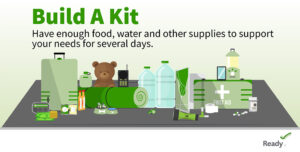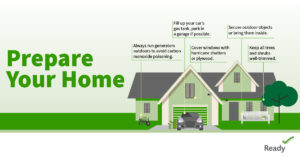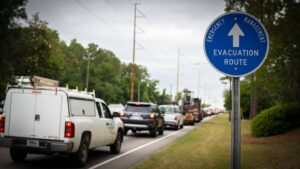
Heather N. Kolich, ANR Agent, UGA Extension Forsyth County
September is National Preparedness Month, and the theme this year is “Start a Conversation.” I recommend starting that conversation with a question: “What could go wrong?”
Risk assessment is an important component of emergency preparedness. Only after we identify or become aware of risks can we take steps to remove or mitigate risk factors. “What could go wrong” can be applied to most situations, plans, and activities.

For example, comedian Ron White tells a story about a storm. He points out a critical truth when he relates, “It’s not that the wind is blowing. It’s what the wind is blowing.” If we apply this insight to a risk assessment around our homes, we might see several things we can do to prevent damage and loss from storm winds. We might determine that a large branch overhanging the roof presents an unacceptable risk that can be mitigated by pruning. We might realize that the patio furniture could be blown away – or blown through a window – and decide to clear a space in the garage to store it and other potential windborne projectiles when a severe storm is expected.
We know that storms are part of our weather cycles and that some of these will disrupt the delivery of electricity and even water to our homes. We can enhance safety and comfort during bad weather by weatherizing our homes during good weather. This can include:
- Insulating walls and attics
- Sealing air leaks around windows and doors with caulk or weather-stripping
- Installing storm doors and windows

The Federal Emergency Management Agency (FEMA) recommends stocking at least a three-day supply of nutritious foods, water, and prescription medications for each family member. We can gradually build up a store of shelf-stable, ready-to-eat foods by adding a couple of extra canned goods – like non-condensed soups, pasta meals, tuna, and vegetables – to the grocery cart during each shopping trip. Don’t forget to purchase extra food for pets, too.
In addition, to get through disruptive storms or other emergencies, you may also need:
- Water for hygiene; plan for one gallon per person day
- Alternate source of fuel for heating and cooking
- Flashlights with extra batteries
- NOAA weather radio
- First aid kit
- Entertainment such as board games, books, cards, and other activities to fend off cabin fever.
Prepare for road emergencies and evacuation situations with a survival kit that includes:
- Warm clothes
- Sturdy walking shoes with warm socks
- Heavy work gloves
- Blanket or sleeping bag
- Hand-crank flashlight and radio
- Bottled water and ready-to-eat foods
- Toiletry items
- Reflective vest
- Whistle and other items for signaling help

If evacuation is a possibility, prepare go-kits with essential supplies, plan ahead where to go, and make sure everyone in the household knows where to meet up. It’s a good idea to keep vehicles fueled above the half-full mark, as gasoline may not be available during power outages. In addition, put together copies of important documents to bring with you, including:
- Insurance policies and documents
- Health cards
- List of medications
- Birth certificates
- List of important phone numbers
For more information about emergency preparedness, visit Ready.gov (https://www.ready.gov/) and download the UGA Extension Home Emergency Preparedness Handbook from https://extension.uga.edu/publications/detail.html?number=B1428&title=home-emergency-preparedness-handbook.